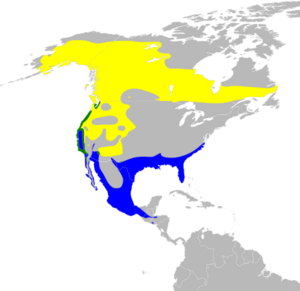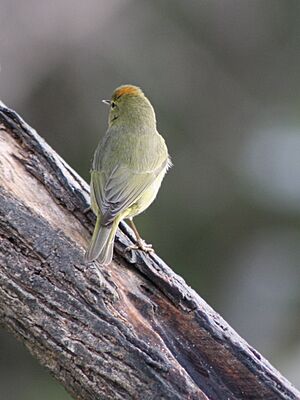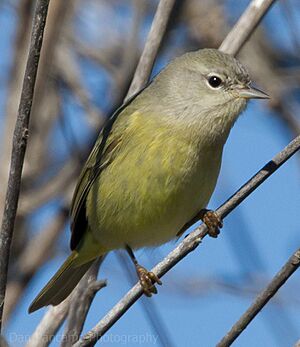Orange-crowned warbler facts for kids
Quick facts for kids Orange-crowned warbler |
|
|---|---|
 |
|
| Conservation status | |
| Scientific classification | |
| Genus: |
Leiothlypis
|
| Species: |
celata
|
 |
|
| Range of L. celata Breeding range Year-round range Wintering range | |
| Synonyms | |
|
Helmintophila celata |
|
The orange-crowned warbler (Leiothlypis celata) is a small, active songbird. It belongs to the New World warbler family. These birds are known for their olive-green feathers and a secret orange patch on their head.
Contents
Meet the Orange-Crowned Warbler
Orange-crowned warblers are small birds with a simple look. They have olive-grey feathers on their backs and yellowish feathers underneath. You might notice faint stripes on their chests. Their beaks are thin and pointed, perfect for catching insects.
They have a faint line above each eye and a broken ring around their eyes. The special orange patch on their head is usually hidden. This is why they are called "celata," which means "secret" or "hidden" in Latin!
How to Spot Them
It can be tricky to tell orange-crowned warblers apart from other warblers. They don't have bright colors, strong face markings, or stripes on their wings. This makes them look a bit plain compared to some of their relatives.
Younger birds and females often look duller than adult males. Birds living in the western parts of their range tend to be yellower than those in the east.
Their Song and Calls
The song of an orange-crowned warbler is a soft, trilling sound. It starts louder and then slowly gets quieter and lower in pitch. Their call is a short, high-pitched "chip!"
Size and Weight
These little birds are quite small. They are about 4.8 to 5.3 inches (12 to 13.5 cm) long. They weigh around 0.3 ounces (9 grams), which is about the same as two quarters! Their wingspan is about 7.25 inches (18.4 cm).
Where Do Orange-Crowned Warblers Live?
Orange-crowned warblers live in North America. They like open areas with lots of shrubs and bushes.
Their Travels
These birds are migratory. This means they travel long distances between seasons.
- They spend their summers breeding in places like central Alaska, across Canada, and the western United States.
- When winter comes, they fly south. They spend the colder months in the southern United States and as far south as Central America.
While they are quite common in the western parts of the United States, you won't see them as often in the eastern regions.
Life and Habits of the Warbler
Orange-crowned warblers are busy birds. They are always moving and looking for food.
Nesting and Reproduction
When it's time to have babies, the female warbler builds a small, cup-shaped nest. She hides it very well on the ground, often under plants, or low down in a bush.
She lays about four to six eggs in the nest. Both the mother and father work together to feed their young chicks until they are ready to leave the nest.
What Do They Eat?
Orange-crowned warblers are always looking for food. They fly from branch to branch in low shrubs. Sometimes, they even hover in the air to grab a tasty treat!
Their diet includes:
- Insects: These are their main food source.
- Berries: They enjoy different kinds of berries.
- Nectar: They will also sip nectar from flowers, just like hummingbirds!





